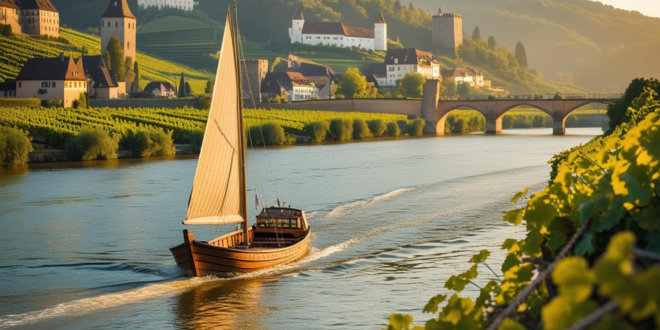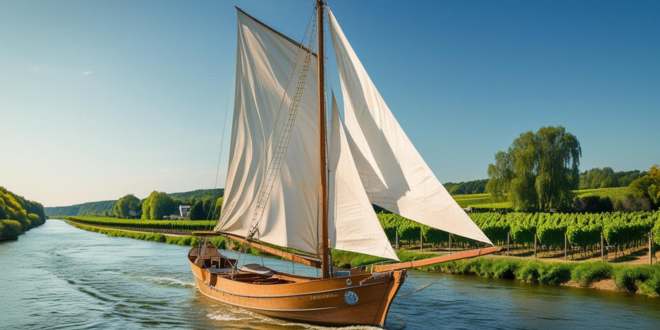Stand-Up Paddleboarding (SUP) has surged in popularity across Germany, offering an accessible and scenic way to enjoy the country’s stunning natural landscapes. With calm waters, lush shorelines, and a growing outdoor recreation culture, German lakes provide the perfect playground for paddlers of all levels. Whether you’re a beginner or an experienced enthusiast, exploring Stand-Up Paddleboarding on German lakes is a refreshing way to connect with nature.
If you’re wondering how to start SUP in Germany, you’ll be pleased to know that rental centers, beginner lessons, and guided tours are widely available, especially near major lake regions. But first, many ask: Is SUP allowed on German lakes? The answer is generally yes — though local regulations may apply, so it’s important to check signage and follow environmental guidelines.
For those planning their next adventure, discovering the best lakes in Germany for stand-up paddleboarding is key. From the Alpine foothills to the forests of Brandenburg, we’ll also highlight the top 10 stand-up paddleboarding spots in Germany you need to visit. Plus, don’t miss our essential stand-up paddleboarding gear guide for paddling in Germany, covering everything from inflatable boards to safety equipment.
Stand-Up Paddleboarding (SUP) on German Lakes
Stand-Up Paddleboarding (SUP) has become a popular outdoor activity across Germany, offering a unique way to explore the country’s stunning natural landscapes. With thousands of lakes nestled in forests, mountains, and lowland regions, Germany provides ideal conditions for paddlers of all levels.
SUP is not only a fun water sport but also a great full-body workout and a peaceful way to connect with nature. Calm waters, well-maintained access points, and growing SUP infrastructure make German lakes perfect for beginners and experienced paddlers alike. Whether you’re gliding across alpine lakes in Bavaria or touring quiet waterways in Brandenburg, SUP offers unforgettable experiences.
Many lakeside towns offer rentals, lessons, and guided tours, making it easy to get started. As awareness of eco-friendly recreation grows, more paddlers are embracing responsible practices. With the right gear and knowledge of local rules, SUP on German lakes is a safe, accessible, and rewarding adventure waiting to be explored.

Best Lakes in Germany for Stand-Up Paddleboarding
Germany is home to numerous lakes perfect for stand-up paddleboarding, combining calm waters, scenic beauty, and excellent access. Among the top choices is Lake Tegernsee in Bavaria, known for its crystal-clear water and mountain backdrop. Chiemsee, often called the “Bavarian Sea,” offers wide, flat areas ideal for beginners and long-distance paddling. In Berlin, Müggelsee provides urban paddlers a peaceful escape into nature.
The Mecklenburg Lake District features interconnected waterways perfect for multi-day SUP tours. Stechlinsee impresses with its protected status and pristine environment, great for wildlife spotting. Ammersee and Königssee offer alpine views and refreshing waters, while Bodensee (Lake Constance) allows cross-border paddling into Austria and Switzerland.
Northern lakes like Schweriner See are wind-protected and family-friendly. Most of these lakes have rental stations, guided tours, and beginner zones. Whether you seek adventure, tranquility, or fitness, the best lakes in Germany for SUP deliver unforgettable paddling experiences in breathtaking natural settings
How to Start SUP in Germany
Starting stand-up paddleboarding (SUP) in Germany is easy and accessible for beginners. First, choose a calm, flat-water lake such as Müggelsee in Berlin or Tegernsee in Bavaria—ideal for learning balance and technique.
Many local watersports centers offer introductory SUP lessons (often in English or German), where certified instructors teach you how to stand, paddle, turn, and fall safely. Rentals are widely available by the hour or day, typically including the board, paddle, leash, and life jacket. Most beginners start on inflatable boards, which are stable and user-friendly.
Wear quick-dry clothing, sunscreen, and water shoes. In cooler months, consider a wetsuit. Always check weather and wind conditions before heading out, and avoid restricted or protected areas.
Joining a SUP club or community can also help you learn faster and meet fellow paddlers. With Germany’s growing SUP culture, clear signage at lakes, and eco-conscious practices encouraged, starting your paddleboarding journey here is both safe and enjoyable. In no time, you’ll be gliding across serene lakes with confidence.
Top 10 Stand-Up Paddleboarding Spots in Germany You Need to Visit
- Lake Tegernsee (Bavaria)
- Chiemsee (Bavaria)
- Müggelsee (Berlin)
- Königssee (Bavaria)
- Stechlinsee (Brandenburg)
- Bodensee (Lake Constance)
- Ammersee (Bavaria)
Lake Tegernsee (Bavaria)
Crystal-clear water, alpine views, and excellent rental options.
Chiemsee (Bavaria)
Germany’s largest lake in the south, perfect for long paddles and island visits.
Müggelsee (Berlin)
Easily accessible urban lake with calm waters and nature trails.
Königssee (Bavaria)
Stunning alpine lake with emerald waters and boat-free zones ideal for SUP.
Stechlinsee (Brandenburg)
Protected nature reserve with pristine water and rich biodiversity.
Bodensee (Lake Constance)
Cross-border paddling with views of the Alps and charming lakeside towns.
Ammersee (Bavaria)
Less crowded than nearby lakes, great for peaceful morning paddles.

Is SUP Allowed on German Lakes?
Yes, stand-up paddleboarding (SUP) is generally allowed on most lakes in Germany, but regulations can vary by federal state (Bundesland) and specific lake. SUP is classified as a non-motorized watercraft, similar to kayaks or canoes, so no license or registration is required. However, some lakes—especially nature reserves, drinking water reservoirs, or designated swimming zones—may restrict or ban SUP to protect wildlife or public safety.
Always check local signage at access points before launching. In Bavaria and Brandenburg, for example, many lakes allow SUP freely, while in Baden-Württemberg, some restrictions apply near protected areas. It’s also wise to avoid early mornings or windy conditions when visibility or stability may be compromised.
Carrying a coiled ankle leash and wearing a life jacket is strongly recommended, even if not legally required. Some regions encourage voluntary liability insurance for water sports. By respecting local rules and environmental guidelines, paddlers can safely enjoy SUP on Germany’s beautiful lakes year-round.
Stand-Up Paddleboarding Gear Guide for Paddling in Germany
- SUP Board: Inflatable boards (iSUPs) are popular for portability and durability; hard boards offer better performance on flat water.
- Paddle: Adjustable paddles are ideal for beginners; carbon fiber is lightweight but pricier.
- Leash: Always use a coiled ankle leash to stay connected to your board in open water.
- Life Jacket (PFD): Highly recommended, especially for children and in windy or open areas.
- Clothing: Quick-dry sportswear in summer; wetsuit or drysuit in spring/autumn.
- Footwear: Water shoes or neoprene boots protect feet on rocky shores.
Conclusion
Stand-Up Paddleboarding (SUP) on German lakes offers a unique blend of relaxation, fitness, and outdoor adventure, making it one of the most enjoyable ways to explore the country’s natural beauty. From the serene waters of Bavaria to the tranquil lakes of Mecklenburg, there are countless spots where paddlers can glide across mirror-like surfaces surrounded by forests, hills, and wildlife.
We’ve covered the best lakes in Germany for stand-up paddleboarding, highlighting destinations that combine accessibility, scenic views, and calm conditions ideal for all skill levels. Whether you’re a beginner wondering how to start SUP in Germany or an experienced paddler seeking new routes, the country’s growing SUP infrastructure — including rentals, schools, and guided tours — makes it easier than ever to get started.
You’ve also discovered the top 10 stand-up paddleboarding spots in Germany you need to visit, from Lake Tegernsee to the Müggelsee in Berlin. And to ensure a safe and legal experience, we addressed the important question: is SUP allowed on German lakes? While generally permitted, local rules can vary, so always check signage and respect nature protection zones.
Finally, our stand-up paddleboarding gear guide for paddling in Germany ensures you’re equipped with the right board, paddle, life vest, and clothing for changing weather conditions. With the right knowledge and preparation, SUP in Germany isn’t just a sport — it’s a lifestyle.
Is stand-up paddleboarding (SUP) allowed on lakes in Germany?
Yes, SUP is generally allowed on most lakes in Germany. However, rules vary by region and specific lake. Some nature reserves or protected areas may restrict access. Always check local signage and regulations before launching. In many places, non-motorized boards like SUPs are permitted, but swimming zones or conservation areas may be off-limits.
1. What are the best lakes in Germany for SUP?
Top lakes for SUP in Germany include Lake Tegernsee, Chiemsee, and Königssee in Bavaria, Stechlinsee in Brandenburg, and the Mecklenburg Lake District. These offer calm waters, scenic views, and good access points. Lakes near the Alps provide stunning mountain backdrops, while northern lakes are ideal for peaceful paddling in forested areas.
2. How to start SUP in Germany as a beginner?
Beginners can start SUP in Germany by taking a lesson or renting gear from local providers. Many lakeside towns offer introductory courses covering balance, paddling technique, and safety. Choose a calm, flat-water lake, wear a life jacket, and check weather conditions. Start on your knees, then gradually stand up as you gain confidence.
3. Do I need a license or permit to SUP on German lakes?
No, you don’t need a license or permit for stand-up paddleboarding on most German lakes. SUP is treated like non-motorized watercraft, so no registration is required. However, always respect local rules—some lakes may have restrictions. Carrying liability insurance is recommended, though not always mandatory.
4. Where can I rent a SUP board in Germany?
SUP boards can be rented at popular lakeside spots like Lake Tegernsee, Chiemsee, Müggelsee (Berlin), and the Mecklenburg Lake District. Numerous watersports centers, marinas, and outdoor shops offer hourly or daily rentals. Booking online in advance is recommended during peak season. Most rental shops also provide paddles, leashes, and life jackets.
5. Are there SUP lessons or schools available in Germany?
Yes, SUP lessons and certified schools are widely available across Germany, especially in Bavaria, Berlin, and along major lakes. Courses range from beginner sessions to advanced techniques like SUP yoga or touring. Instructors teach balance, stroke technique, safety, and water rules. Group and private lessons are offered in summer, with some schools operating year-round.
6. What is the best time of year for SUP in Germany?
The best time for SUP in Germany is from May to September, when temperatures are warmer and waters are calmer. July and August are ideal for beginners. Spring and early autumn can also be pleasant, but water is colder—wear a wetsuit or drysuit. Winter SUP is possible with proper gear but not recommended for beginners.
7. Do I need to wear a life jacket while SUP in Germany?
While not legally required everywhere, wearing a life jacket (or buoyancy aid) is strongly recommended in Germany. Some states or lakes may require it, especially for children or in windy conditions. A coiled leash is also advised to stay close to your board. Safety gear enhances confidence, especially for beginners or in open water.
8. Can I bring my own SUP board to German lakes?
Yes, you can bring your own SUP board to most German lakes. Public access points are common, and many parks allow launching from shores. Use designated entry spots to protect nature. Transport boards on your car roof or as luggage. Always clean your board to prevent spreading invasive species between water bodies.
9. Are inflatable SUP boards suitable for German lakes?
Yes, inflatable SUP boards are excellent for German lakes. They’re durable, portable, and stable—ideal for flatwater paddling. Most can handle wind and small waves. High-quality inflatables perform nearly as well as hard boards. Their ease of transport makes them perfect for traveling to lakes across Germany, and they’re great for beginners and families.
10. Are dogs allowed on SUP boards in Germany?
Yes, dogs are allowed on SUP boards in Germany and many owners enjoy paddling with their pets. While not prohibited, check local rules as some lakes restrict animals. Always use a dog life jacket, keep your pet secure, and choose quiet areas to ensure a safe and enjoyable experience for everyone on the water.
